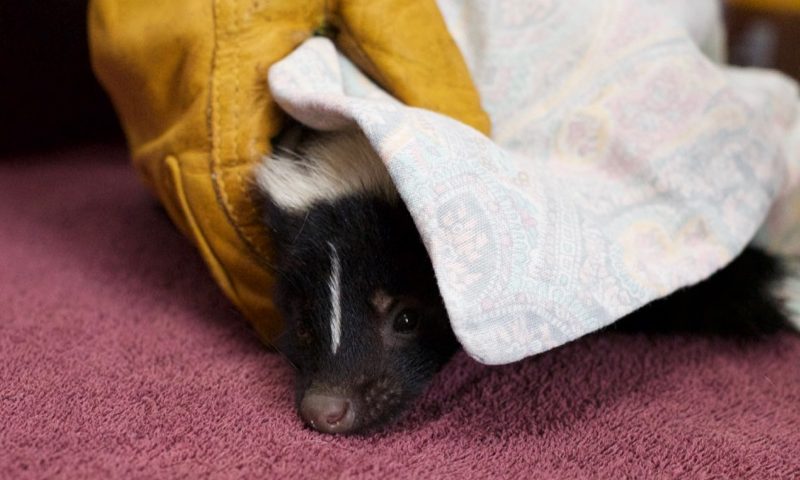
That don’t mean she’s the road to town
Skunk’s got white stripes
That don’t mean she’s the road to town
Just trying to find her lover
Everybody’s got to run her down
Every year the same thrilling tale that Nature has told since time immemorial ends in tragedy for many female Striped Skunks (Mephitis mephitis). In January here in Humboldt (as late as end of February for less temperate areas) female skunks begin to look for a mate. Their evenings are no longer spent watching over any remaining youngsters from the previous year. No longer content to saunter the night time world looking for food and whatever sparks her curiosity, now she is driven. The force of Spring renewal is powerful thing, sending her across fields and forests and very unfortunately, across roads too.
Three days ago, we admitted our first adult female skunk of 2018, who’d likely been hit by a car. Paralyzed and barely conscious, a quick, humane end was the only appropriate care. We rarely admit a skunk who’s been hit by a car simply because they rarely live through the impact. Instead, each January we see a sudden increase in skunks, dead and left to rot by the sides of our roads, from US 101 to the small two lane black tops that criss-cross the agricultural industry of the bottom lands. Samoa Blvd, from Arcata through Manila and south to North Jetty, on a these mid-winter days might have as many as four skunks freshly killed to be seen on the morning commute.
Accidents happen. Many of us can tell a story of hitting a bird, or a squirrel, or a raccoon without warning, with no chance to avoid the impact. It’s a terrible thing. The finality of it – and in the moment, the realized cost – this Swainson’s Thrush had crossed thousands of miles to be here to raise this year’s young, but no, instead, he’s lodged in the bumper of a car that had been speeding along with coffee creamer and a few other things that had been needed at the store. The casual slaughter of billions of wild animals each year by automobile is just another tragedy woven through the fabric of our daily lives.
In the last 12 months, how many Raccoons between Arcata and Manila, between Ferndale and Fernbridge, between Bayside and Freshwater, between Redding and Sacramento were struck and killed and left to bloat and decay by the side of the road, or worse, lure another animal, a Turkey Vulture perhaps, into the same trap. It’s a measure of how far below our concern these lives are, that we can tolerate their dead bodies lying on the margins of our thoroughfares decomposing where they were killed.
It must be the case that many animals are killed simply because we don’t see them, because we never see them. We don’t include them in our ideas about what might happen. We race through the dark as if the world was closed and nothing is real but the road, our headlights, our thoughts and the dark cavern of the sky. And the Road Runner startled by our engine’s roar dashes from the sage into our trajectory, smashed in the night by the predator who never eats – to be mourned if at all, only in the form of young who may have been orphaned to die, and the great sorrow of the Earth which is too large to hear – the Earth who reels in the blood of her freshest wounds and heals as she can from wounds long inflicted – strip mines, factory trawlers, pesticides sprayed across the plains, rivers choked…
There are so many wounds in the world today. Mudslides have killed at least 18 people in Santa Barbara County. In California alone, people in the last year have suffered one catastrophic calamity after another, in a world where greater disaster seems to always loom on the near horizon. It seems that there is little we can do about these wounds on this scale. But it’s simply not true.
Against these tragedies, we have a remedy. This remedy may not lower the temperature but will make the world where we are more beautiful, more just. Dr. King said that the moral arc of the universe bends toward justice, and we can do part of that bending right here, right now, in our tangible world and literally where the rubber meets the road. We can slow down and open our eyes. We can anticipate that we are not alone, free to tread where we will, to pay no regard to who is left broken or killed in our wake.We can find the joy in the nocturnal wild and search for their glowing eyes. We can stop teaching our sons violence as a form of play, violence as a right of passage – to respect the other lives, minds, hearts who they encounter. Far too many patients we’ve admitted were witnessed being run down intentionally, almost always a young man at the wheel. We can teach our sons now what it means to value the soul of another.
The world is made in moments and in each moment we can remember our first loyalty – to Earth and the wild. We can learn to undo our overly built confidence in the machinery of our times and re-align with our wild neighbors, our fellow travelers through this life on Earth, or kith, our kin; -our measured distance surmountable in a leap of recognition, not faith. We can give safe passage to this skunk here now, who is crossing the road, so that she might find who she needs, so that the world is refreshed, so that her young come to be.


